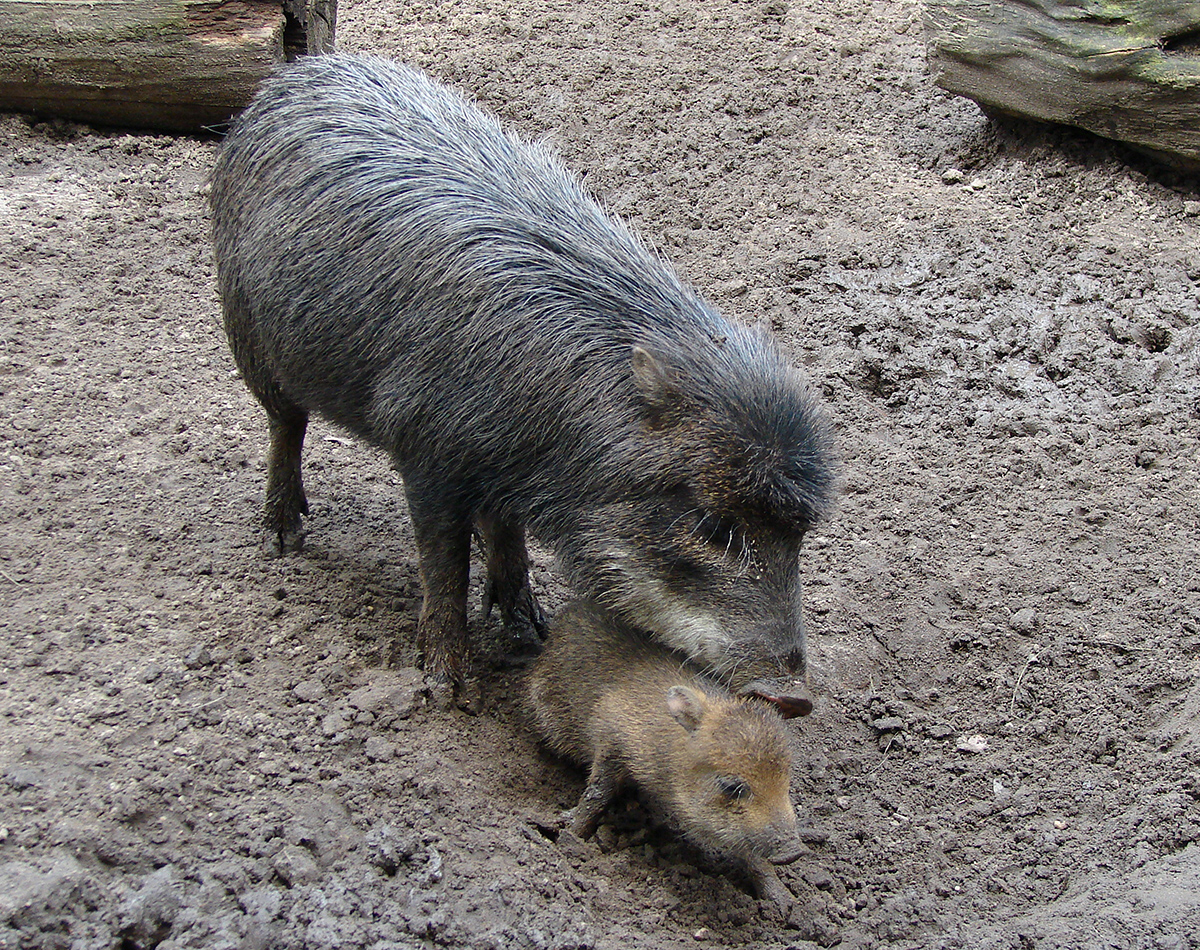The white-lipped peccary, also known as bush hog, wild hog and white-jawed peccary, is native to Central and South America. It got its name because of the white fur around its mouth, chin and lower cheek. In size and shape the white-lipped peccary is like a domesticated pig, with a large head, thick neck, long snout and short tail. Peccaries have large sharp canines and the upper ones point downwards. Their closest relations are pigs but they are in a separate family. Unlike pigs, peccaries have small litters, usually one or two, which follow their mother shortly after birth. In Guyana, there are two species of peccary or wild hog, the white-lipped peccary and the collared peccary. This article will discuss the white-lipped peccary.
Features Of The White-lipped Peccary
- Color – Their color is generally brown or black. The coat is bristly and has hairs running lengthways down the spine growing longer than the hairs running down the body, making a crest, which stands up when the peccary becomes excited.
- Body Structure – The peccary has a round body with a long snout that ends in a circular disk where the nasal cavity starts. They have white markings that start below the snout and run to the cheek area just below the eyes.
- Weight & Length – The head and body length ranges from 90–139 cm, the shoulder height is between 40 and 60 cm, the tail length is from 3–6 cm, and the adult weight is 25–40 kg.
Scientific Classification Of The White-lipped Peccary
White-lipped Peccary – Tayassu pecari [Scientific Classifications]
- Kingdom: Animalia
- Phylum: Chordata
- Class: Mammalia
- Order: Artiodactyla
- Family: Tayassuidae
- Genus: Tayassu
- Species: T. pecari
Habitat Of The White-lipped Peccary
The white-lipped peccary is native to Argentina, Belize, Bolivia, Brazil, Colombia, Costa Rica, Ecuador, French Guiana, Guatemala, Guyana, Honduras, Mexico, Nicaragua, Panama, Paraguay, Peru, Suriname, and Venezuela. They thrive in dense, humid, tropical forests, and can also be found in a wide range of other habitats such dry forests, grasslands, mangrove, Cerrado, and dry xerophytic areas. They range from sea level to an altitude of 1,900 m (6,200 ft).
Diet Of The White-lipped Peccary
White-lipped peccaries are omnivores feeding on fruits, nuts, vegetation, and small amounts of animal matter. Their main predators are the jaguar, puma, and potentially boas. Since the white-lipped peccary relies heavily on fruit, they travel to where the fruit and other essential resources are located. The fruiting season dictates most of their behavior. Fruit is more abundant in primary forests rather than secondary or coastal forests, so their populations are denser in these regions. Generally, a period of fruit shortage occurs during the end of the wet season, so the consumption of secondary foods, such as leaves, stems, and animal parts, is increased.
Reproduction Of The White-lipped Peccary
The white-lipped peccary can breed throughout the year depending on location. The breeding season follows the fruiting season, so the variability can be consistently different in each different region where they are found. The young stay with the mother, but are weaned by six months old. Sexual maturity is reached between one and two years old. The white-lipped peccary lives to be around 13 years old and can give birth to two young at a time.
Ten Facts About The White-lipped Peccary
- The white-lipped peccary is a diurnal feeder, and performs all of its activities during the day, more specifically in the mornings and afternoons.
- Herds can number 20-300, including both males and females, and cases have been reported of herds reaching 2000 peccaries.
- The sex ratio within herds is about 1.4–1.8 females per male.
- The home range for the peccary is from 60–200 km2 in the Peruvian Amazon.
- The peccary can spend up to two-thirds of its day traveling and feeding.
- The range lands of peccaries are massive due to the large number of individuals within the herd.
- Often, peccaries can be smelled before seen because they give off a skunk-like odor.
- They are known to be aggressive when cornered or feel threatened. They give off a loud “bark” and show off their teeth in an attempt to avoid conflict.
- When these animals roam in their range land, they can be very loud, clattering their teeth and grunting to one another to communicate and stay within the herd.
- They communicate with olfactory, acoustic, and physical contact to keep together in the herd. This is essential when warding off predators such as the jaguar, because it may not attack when 200 peccaries are in a herd.
White-lipped Peccary In Guyana
Yes, the white-lipped peccary (Tayassu pecari), is a peccary found in Central and South America (Guyana). Most of its range is in rainforests, but it is also known from a wide range of other habitats such as dry forests, grasslands, mangrove, Cerrado, and dry xerophytic areas. It lives in herds of 20–300 individuals that typically take up about 120 km2 to fully function. Members of this species are omnivorous, feeding mostly on fruit, and are usually found traveling great distances to obtain it. If this resource is in demand and difficult to find, peccaries eat leaves, stems, or animal parts. White-lipped peccaries have several unique attributes that allow them to stay with and identify their herd, which is essential for their survival in the wild.
Article References:
- https://en.wikipedia.org/wiki/White-lipped_peccary
- https://www.worldlandtrust.org/species/mammals/white-lipped-peccary/
- https://www.stabroeknews.com/2012/01/15/features/collared-peccary/
- https://iwokrama.org/mammals/guides/hoof0.html
- Main Image: By I, Chrumps, CC BY-SA 3.0, https://commons.wikimedia.org/w/index.php?curid=2302397








1 Comment